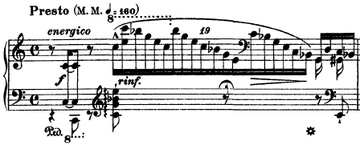Transcendental Etude No. 1 (Liszt)
- Transcendental Etude No. 1 (Liszt)
-

The opening bar of the Transcendental Etude No.
1
Transcendental Etude No. 1 in C "Preludio" is the first of twelve Transcendental Etudes by Franz Liszt. It is a short piece which can be played in less than a minute at concert speed.
Form
Octaved Cs begin the piece, immediately followed by a downward run made up of an arpeggiated C7 chord. A furious set of impetuous notes then climb slowly, and it returns to the octaved Cs and the downward run. The furious set of notes climbs even higher and a set of loud chords blare in fff. The left hand then plays some loud, low pitched trills in succession. After that, the right hand plays some intense arpeggiated figures, and then a final closing chord. This etude is one of the easiest to play along with Transcendental Etude No.3 (Paysage). But by no means should it be underestimated.
External links
Wikimedia Foundation.
2010.
Look at other dictionaries:
Transcendental Etude No. 8 (Liszt) — Transcendental Etude No. 8 in C minor Wilde Jagd (Wild Hunt) is the eighth etude in the twelve Transcendental Etudes by Franz Liszt. It requires exceptional endurance and rigorous technical elements. Strong, supple wrists are required in order to … Wikipedia
Transcendental Etude No. 11 (Liszt) — Transcendental Etude No. 11 in D flat, Harmonies du Soir is the eleventh etude of the set of twelve Transcendental Etudes by Franz Liszt. This etude is a study in harmonies, broken chords played in quick succession, full octave jumps, chromatic… … Wikipedia
Transcendental Etude No. 12 (Liszt) — Transcendental Etude No. 12 in B flat minor is an étude for piano written by composer Franz Liszt. It has the programmatic title Chasse Neige , ( impetuous winds which raise whirls of snow ) and is the 12th and last of the Transcendental Etudes.… … Wikipedia
Transcendental Etude No. 5 (Liszt) — Transcendental Etude No. 5 in B flat Feux Follets (Will o the Wisp) is the fifth etude of the set of twelve Transcendental Etudes by Franz Liszt. Difficulties As with the other works in the Etudes , Feux Follets is considered one of the most… … Wikipedia
Transcendental Etude No. 3 (Liszt) — Transcendental Etude No. 3 in F, Paysage (Landscape), is the third of twelve Transcendental Etudes by Franz Liszt. It is generally considered to be one of the easier studies.The piece suggests a peaceful country scene; the first section is played … Wikipedia
Transcendental Etude No. 9 (Liszt) — The first two bars of the Transcendental Etude No. 9 Etude No. 9 in A flat, Ricordanza is the ninth of the twelve Transcendental Etudes by Franz Liszt. It has wild but gentle cadenzas and demands delicate finger work. There are some areas with… … Wikipedia
Transcendental Etude No. 10 (Liszt) — The first two bars of the Transcendental Etude No. 10 Transcendental Etude No. 10 in F minor, Allegro agitato molto is the tenth Transcendental Etude of a set of twelve by Franz Liszt. It is possibly the most played of the etudes and has a… … Wikipedia
Transcendental Etude No. 7 (Liszt) — The first two bars of the Transcendental Etude No. 7 Transcendental Etude No. 7 in E flat, Eroica is the seventh of the twelve Transcendental Etudes by Franz Liszt. It is a study of rapid downward runs, bravura and octaves (at the end). In a… … Wikipedia
Transcendental Etude No. 2 (Liszt) — The first deceptively simple bars of the Transcendental Etude No. 2 Transcendental Etude No. 2 in A minor, Molto Vivace , or Fusées (French: “Rockets”) is the 2nd piece of the Transcendental Etudes by Franz Liszt. The title Fusées is not Liszt s… … Wikipedia
Transcendental Etude No. 6 (Liszt) — The first bar of the Transcendental Etude No. 6 Franz Liszt s Transcendental Etude No. 6 in G minor Vision is the sixth of his twelve Transcendental Etudes. It is a study of the extensions of the hand, hands moving in opposite directions,… … Wikipedia

